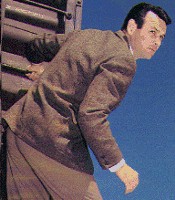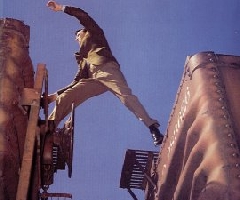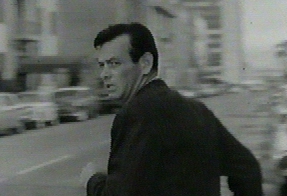




Even Houdini probably used an assistant sometimes, and Kimble also
gets by with a little help from his friends on occasions when he just
can't go it alone. As Jeff Fox points out, ``a recurring theme'' of the
show involves ``Dr. Kimble being aided in his escape from the law by someone
who appreciated his unobtrusiveness and sincerity.'' More often than not, this
``someone'' is one of Dr. Kimble's many female admirers,
like the gushy young hostage in WINGS OF
AN ANGEL or the hospital nurse in NOBODY
LOSES ALL THE TIME, who helps Kimble make not one but two plausible,
suspenseful escapes within the space of a single episode.
DOSSIER ON A
DIPLOMAT is capped off with another neat little escape made
possible by a friendly femme, this time Diana Hyland. Kimble
has found refuge in an African embassy because the ambassador has
offered him diplomatic immunity. But when the ambassador's
deathly illness incapacitates him, his
unsympathetic wife decides to close up the embassy, leaving Kimble to
his fate. Gerard and some other cops are waiting outside the embassy
like so many circling vultures, watching suspiciously as crate after
crate of furniture and documents are loaded onto the moving van. They
can't go in and arrest Kimble until the ambassador's residence is
officially vacated. Finally the moving van is closed up and rumbles
off, but suddenly Diana, who plays the ambassador's secretary, rushes
out with a bundle of dresses and a table lamp or something. When
Gerard tells her that the moving van just left, she looks annoyed and
wonders aloud why they didn't wait for the rest of the boxes and stuff
to be loaded. Gerard and his local sidekick du jour exchange
meaningful glances and rush to their patrol cars, speeding off in
pursuit of the moving van. But of course Diana was just pretending
that the van was supposed to wait, so that the cops would think Kimble
had hijacked it. By chasing after it, they have left the back entrance
to the embassy unguarded, allowing Kimble to sneak out and hop onto
(what else?) a waiting bus, completing his escape.
But not every clever escape is helped along by a woman. Kimble's male
friends do their share as well, in such episodes as
THE IRON MAIDEN and
TUG OF WAR.
THE IRON MAIDEN is the one
in which Kimble gets trapped at the bottom of a mine shaft; by the
time the rescue operation is ready to commence, the cops have been
tipped off and are waiting for him on the surface. Meanwhile, though,
Kimble has explained his plight to some of his miner buddies who are
trapped with him. By a stroke of luck, they happen to be Native
Americans, and hence they are able to communicate in their tribal
language with their colleagues on the surface, who are coordinating
the rescue effort. In particular, they radio special instructions to
the operator of the crane which is being used to scoop them out of the
mine. To the cops, it sounds like so much gibberish, but in reality,
they are plotting an escape route for Kimble. When the crane operator
finally lifts the trapped miners, including Kimble, to the surface, he
doesn't deposit them in the front of the mine, where the police expect
him to; instead he maneuvers the crane all the way over to the
opposite end of the mine, giving Kimble the crucial head start he
needs to elude capture.
A particularly elegant escape is orchestrated by old sheriff Arthur
O'Connell in TUG OF WAR.
O'Connell has been engaged in, well, a tug of war with a younger
lawman over the course of the entire episode. They are both escorting
Kimble back to town after taking him prisoner in the wilderness. But
they are rivals, each jealous of the other, and they miss no
opportunity to secretly sabotage each other in petty ways. After a few
days of hiking through the back country, old Arthur is near the end of
his rope. His heart isn't what it used to be, and it doesn't help
matters that his younger colleague has tampered with his supply of
medication, to gain an unfair advantage in their little feud. When the
old sheriff is suddenly struck down by a heart attack or something,
and is at death's door, he asks Kimble to
bend down next to him and whisperingly asks him if he is really
innocent, as he claims. He points out that Kimble evidently has
nothing to gain by lying to him now, since he is about to die and is
therefore powerless to do anything to save Kimble. His young, virile
nemesis holds the one rifle they have between them. When Kimble
continues to swear that he's just a victim of blind justice, old
Arthur realizes that he must be telling the truth. And, as it turns
out, there is something Arthur can do to save Kimble after all, even
though he is about to die and the other cop has the gun. Arthur simply
opens his cupped right hand, wordlessly revealing to Kimble the six
bullets he has been concealing there. He has in fact previously
unloaded the young cop's rifle, and thereby has managed to keep the
upper hand after all, old and feeble as he is. Arthur then proceeds to
kick the bucket, but Kimble, armed with this liberating knowledge, now
just marches up to the young cop and takes the harmless, unloaded
rifle out of his flabbergasted hands. Then he knocks him out or
something and vanishes into the landscape.
But even a loaded gun does not necessarily present an obstacle to
Kimble's escape plans, if the person holding the gun is a basically
decent person who obeys the law more out of habit than deep
conviction. In such cases, Kimble's avenue of escape is simple — he
just walks away, daring the waffling gun wielder to shoot him in the
back. This tactic is successfully employed for instance at the climax
of DETOUR ON A
ROAD GOING NOWHERE. Confronted with the choice between shooting
down a kindly do-gooder who happens to be wanted by the police, and
just minding their own business and letting him go on his way, most
people outside of the law-enforcement
community have a clear preference.
Of course, not all of Kimble's remarkable exploits are quite as
convincing as the ones mentioned so far. Some of his escapes, in fact,
are downright ridiculous. Take the one at the end of
NIGHTMARE AT NORTHOAK,
for instance. Kimble has just been tracked down as the
result of a nationwide manhunt. Eagle-eyed Lieutenant Gerard himself
has swooped in to supervise his extradition. Yet, after the friendly
wife of the local sheriff slips Kimble the key to his jail cell during
visiting hours, all Kimble has to do to escape is knock out Gerard
with one blow, and then wave Gerard's gun at a single terrified local
deputy. Then, since no one else seems to have bothered to show up that
day at the police station, the coast is clear for Kimble to run out
into the street and vanish. In another episode,
NOT WITH A WHIMPER,
Kimble is totally surrounded, but manages to make a clean getaway by
waving a box with some wires at the cops and yelling about how he has
a bomb.
In fact, though, there's something a little silly about all these
escape scenarios when one stops and thinks about them a little, even
the ones that seem very plausible and gripping while they are
unfolding. Couldn't Gerard have radioed for back-up in
DOSSIER ON A DIPLOMAT,
rather than racing off and leaving a huge gap in his
perimeter? And what about that team that had Kimble surrounded in the
law school? Didn't they think to seal the exits and check the IDs of
everyone in the place one by one? Though they drive around in those
shiningly modern '60s black-and-white squad cars and utilize all the
then-up-to-date techniques of forensic science, more often than not
Kimble's pursuers come off like nothing more than poor second cousins
to the good old fashioned Keystone Cops.
 Back to HOMEPAGE OF THE HUNTED <http://unchance.net/Fugitive>
Back to HOMEPAGE OF THE HUNTED <http://unchance.net/Fugitive>